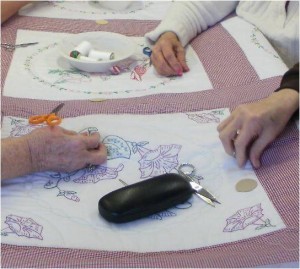 Last summer I began a new project in the community that my father’s family was from. I began a quilt documentation.
Last summer I began a new project in the community that my father’s family was from. I began a quilt documentation.
This started because of a class in American folk crafts that I was taking. I knew my grandmother, who had moved back to the community in which she had grown up, participated in a quilting group that had family and old friends in it. Her grandmothers, along with women from all the farming community, developed the quilting group in the early 1900s. Her mother, along with her neighbors, used weekly quilting bees to build friendships and accomplish community goals throughout the 20th century, such as auctioning quilts to raise money for a piano for the school. Their ultimate financial goal was to someday have a community center for quilting. That finally happened in the late 1950s when the group sold their quilting to raise money to complete the local church basement. Today, my grandmother and one of her sisters, and other lifelong close friends, still come together weekly at the church, as their mothers did, to share stories and news, and stitch a quilt. Their stitching raises money for the church building fund. Quilting groups such as theirs still meet at several rural churches of the county in which they live.
Quilt documentation is a wonderful vehicle for documenting local community history. I thought of this as not only a class paper idea, but a way to fill out the community history with details of who people were in the community. It was also a documentation of the creative pathways the community has trod. Quiltings in this community have been neighborhood and church events for more than a hundred years. The documentation is giving a chance to explore how quilt patterns were impacted by heritage, local availability of materials, the sharing of patterns, media, and creative ideas.
A quilt documentation involves photographing a quilt, and writing down its dimensions and the fabrics used. A biography of the quilter is noted, along with pictures of the quilter and, possibly, the quilter quilting. Hopefully, an interview with the quilter or a family member is recorded. Then, the documentation is gathered together, cataloged, and given to a community history repository or an appropriate archive. At that point, the quilt documents will become available for researchers, able to put the patterns of behavior together and then analyze the community within the context of its culture.